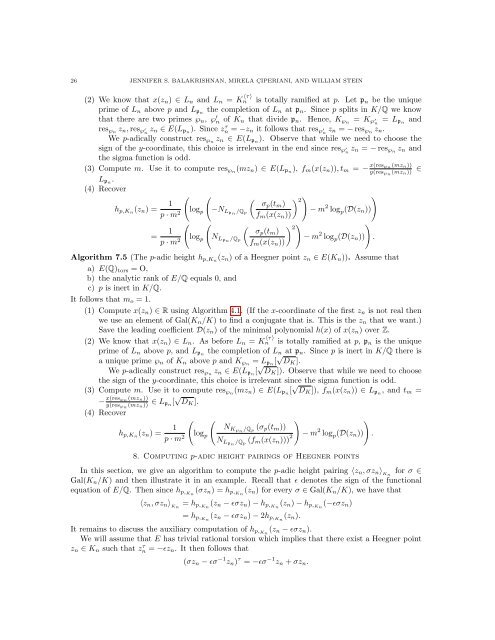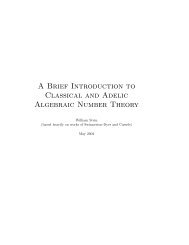p-ADIC HEIGHTS OF HEEGNER POINTS AND ANTICYCLOTOMIC ...
p-ADIC HEIGHTS OF HEEGNER POINTS AND ANTICYCLOTOMIC ...
p-ADIC HEIGHTS OF HEEGNER POINTS AND ANTICYCLOTOMIC ...
You also want an ePaper? Increase the reach of your titles
YUMPU automatically turns print PDFs into web optimized ePapers that Google loves.
26 JENNIFER S. BALAKRISHNAN, MIRELA ÇIPERIANI, <strong>AND</strong> WILLIAM STEIN<br />
(2) We know that x(zn) ∈ Ln and Ln = K 〈τ〉<br />
n<br />
is totally ramified at p. Let pn be the unique<br />
prime of Ln above p and Lpn the completion of Ln at pn. Since p splits in K/Q we know<br />
that there are two primes ℘n, ℘ ′ n of Kn that divide pn. Hence, K℘n = K℘ ′ n = Lpn and<br />
res℘n zn, res℘ ′ n zn ∈ E(Lpn). Since z τ n = −zn it follows that res℘ ′ n zn = − res℘n zn.<br />
We p-adically construct res℘n zn ∈ E(Lpn ). Observe that while we need to choose the<br />
sign of the y-coordinate, this choice is irrelevant in the end since res℘ ′ n zn = − res℘n zn and<br />
the sigma function is odd.<br />
(3) Compute m. Use it to compute res℘n (mzn) ∈ E(Lpn ), fm(x(zn)), tm = −<br />
Lpn .<br />
(4) Recover<br />
hp,Kn (zn) = 1<br />
p · m2 <br />
2<br />
σp(tm)<br />
logp −NLpn /Qp<br />
− m<br />
fm(x(zn))<br />
2 <br />
logp(D(zn)) = 1<br />
p · m2 <br />
2<br />
σp(tm)<br />
logp NLpn /Qp<br />
− m<br />
fm(x(zn))<br />
2 <br />
logp(D(zn)) .<br />
x(res℘n (mzn))<br />
y(res℘n<br />
(mzn)) ∈<br />
Algorithm 7.5 (The p-adic height hp,Kn(zn) of a Heegner point zn ∈ E(Kn)). Assume that<br />
a) E(Q)tors = O,<br />
b) the analytic rank of E/Q equals 0, and<br />
c) p is inert in K/Q.<br />
It follows that mo = 1.<br />
(1) Compute x(zn) ∈ R using Algorithm 4.1. (If the x-coordinate of the first zn is not real then<br />
we use an element of Gal(Kn/K) to find a conjugate that is. This is the zn that we want.)<br />
Save the leading coefficient D(zn) of the minimal polynomial h(x) of x(zn) over Z.<br />
(2) We know that x(zn) ∈ Ln. As before Ln = K 〈τ〉<br />
n is totally ramified at p, pn is the unique<br />
prime of Ln above p, and Lpn the completion of Ln at pn. Since p is inert in K/Q there is<br />
a unique prime ℘n of Kn above p and K℘n = Lpn[ √ DK].<br />
We p-adically construct res℘n zn ∈ E(Lpn [√DK]). Observe that while we need to choose<br />
the sign of the y-coordinate, this choice is irrelevant since the sigma function is odd.<br />
(3) Compute m. Use it to compute res℘n(mzn) ∈ E(Lpn[ √ DK]), fm(x(zn)) ∈ Lpn, and tm =<br />
x(res℘n (mzn))<br />
− y(res℘n (mzn)) ∈ Lpn [√DK]. (4) Recover<br />
hp,Kn(zn) = 1<br />
p · m 2<br />
<br />
log p<br />
NK℘n /Qp (σp(tm))<br />
2<br />
NLpn /Qp (fm(x(zn)))<br />
<br />
− m 2 log p(D(zn))<br />
8. Computing p-adic height pairings of Heegner points<br />
In this section, we give an algorithm to compute the p-adic height pairing 〈zn, σzn〉 Kn for σ ∈<br />
Gal(Kn/K) and then illustrate it in an example. Recall that ɛ denotes the sign of the functional<br />
equation of E/Q. Then since hp,Kn (σzn) = hp,Kn (zn) for every σ ∈ Gal(Kn/K), we have that<br />
〈zn, σzn〉 Kn = hp,Kn (zn − ɛσzn) − hp,Kn (zn) − hp,Kn (−ɛσzn)<br />
= hp,Kn (zn − ɛσzn) − 2hp,Kn (zn).<br />
It remains to discuss the auxiliary computation of hp,Kn (zn − ɛσzn).<br />
We will assume that E has trivial rational torsion which implies that there exist a Heegner point<br />
zn ∈ Kn such that z τ n = −ɛzn. It then follows that<br />
(σzn − ɛσ −1 zn) τ = −ɛσ −1 zn + σzn.<br />
<br />
.
















